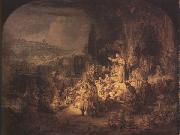
|
REMBRANDT Harmenszoon van Rijn
|
|||
|
|
|||
| Born 1606, Died 1669.One of the great Dutch painters and printmakers of the 17th century, Rembrandt van Rijn is best known for his expressive use of light and shadow (also called chiaroscuro) in his many portraits. Raised in Leiden, he studied with Pieter Lastman (1583-1633) in Amsterdam, then returned to Leiden around 1625 and set up shop as a teacher and portrait artist. Sometime between 1630 and 1632 Rembrandt relocated to Amsterdam, where he spent the rest of his career. Though he had his detractors (some of whom considered him coarse and "low born"), Rembrandt was successful and famous during his lifetime, though he fell on financial hard times in his later years. He was a master printer and produced hundreds of group portraits and historical paintings, including The Anatomy Lesson of Dr. Tulp (1632), The Military Company of Captain Frans Banning Cocq (1642) and Aristotle with a Bust of Homer (1653). His portraits -- including a lifelong trail of intriguing and rather frank self-portraits -- reveal his interest in psychological study and continue to be admired as landmarks in Western art. The Military Company of Captain Frans Banning Cocq is also known as "The Night Watch" because it was thought the painting depicted a nighttime scene. When the painting was cleaned in the 1940s it became obvious that it depicted a daytime scene... He married Saskia van Ulenburgh (also Uylenburgh) in 1634. | |||
|
|
|||
|
Fohn the Baptist preaching (mk33) new8/REMBRANDT Harmenszoon van Rijn-365693.jpg Painting ID:: 24596 |
c.1634/35 Canvas on panel 62.7x81cm Berlin,Staatliche Museen Preussischer | ||
|
|
|||
|
CORNELIS VAN HAARLEM
|
|||
|
|
|||
| Dutch painter (b. 1562, Haarlem, d. 1638, Dutch painter and draughtsman, was one of the leading Northern Mannerist artists in The Netherlands, and an important forerunner of Frans Hals as a portraitist. Cornelis Corneliszoon was a member of the Mannerist school of Haarlem, which was highly influenced by the work of Bartholomeus Spranger, whose drawings were brought to Haarlem by Carel van Mander in 1585, and had a strong immediate effect.[1] He painted mainly portraits as well as mythological and Biblical subjects. Initially Corneliszoon painted large-size, highly stylized works with Italianate nudes in twisted poses with a grotesque, unnatural anatomy. Later, his style changed to one based on the Netherlandish realist tradition. When his parents fled Haarlem in 1572, as the Spanish army laid siege to the city during the Eighty Years' War, Corneliszoon remained behind and was raised by the painter Pieter Pietersz., his first teacher. Later, Corneliszoon studied in Rouen, France and Antwerp, Belgium. Corneliszoon in 1583 received his first official commission from the city of Haarlem, a militia company portrait, the Banquet of the Haarlem Civic Guard. He later became city painter of Haarlem and received numerous official commissions. As a portrait painter, both of groups and individuals, he was an important influence on Frans Hals. Together with Carel van Mander, Hendrick Goltzius and other artists, Corneliszoon formed the Haarlem Academy or "Haarlem Mannerists". Probably this was a very informal grouping, perhaps meeting to draw nude models, and certainly to exchange artistic views.[2] Corneliszoon also played a role in reorganizing the Haarlem artists' and artisans' Guild of St. Luke, eliminating its medieval organization and raising the status of the artists. Corneliszoon married Maritgen Arentsdr Deyman, the daughter of a mayor of Haarlem, sometime before 1603. | |||
|
|
|||
|
Fohn the Baptist preaching (mk33) new8/CORNELIS VAN HAARLEM-386579.jpg Painting ID:: 24597 |
London The National Gallery | ||
|
|
|||
|
Also Buy::. For Following Paintings / Artists / Products, Please Use Our Search Online: |









